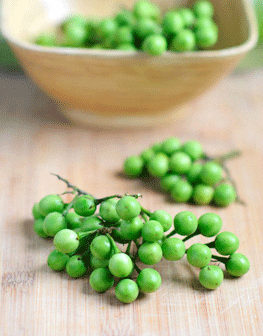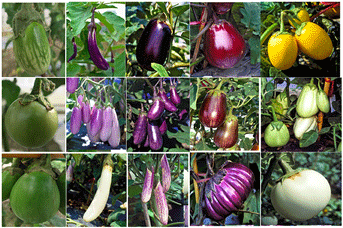Glory of BRINJALS: All brinjals are from the Solanaceae or the nightshade family and come in several shapes and colours, although aubergines is usually big round deep royal purple. Interestingly, brinjals are kissing cousins of potatoes, tomatoes and bell peppers (capsicums).
By Tara Narayan
I LOVE aubergine as in the big silky spongy royal purple ones and I never call these brinjals or egg plants or even baingan in Hindi! In Guju we call them ringna and they may be small or big, round or oval or elongated thick-finger sized, in color ivory, creamy green, streaky purple or pure glossy purple. Sometimes with the Goan pavement vendors one may see the slender finger sized ones which are ideal for stuffing with masala and shallow frying in a bit of tempered with thymol seeds and pinch of hing oil, low heat please. Cover and you also get some additional steam cooking too.
I got this baingan-ka-bharta jhatka because just last week my friend Ajanta said she was going to make baingan ka bharta. And suddenly I remembered this glorious north Indian dish made after painstakingly slow roasting large purple aubergines over the gas flame till they are char cooked…remove, cool a bit and scrape off the burnt split skin remains. Mash and make bharta as you wish. The highway side dhabba up north specialize in baingan ka bharta. Ajanta said in traditional Bengali-style they just mash up roasted aubergine and stir in fresh diced onion, ginger and garlic, green chilies and green coriander, salt per taste, dribble in some cold pressed mustard oil, serve with rice…yummyliciouos!

(This Bengali-style baingan bharta is magical to eat in Kalkota during the winter months.) Begun Bhorta (Spicy mashed eggplant, actually a Bangladeshi classic) TAKE half kg purple aubergine; half cup finely chopped onion; 4 pieces red chilli of choice; salt to taste; 1 tbs pure mustard oil; 5 to 6 garlic cloves; as much finely cut coriander leaves as you wish. TO make first roast dry red chili pieces on a heated pan for 2 to3 minutes till slightly burnt. Next wash aubergine and thick slice, rub mustard oil on each side of the slices and roast them on heated pan over medium flame. Roast till cooked through. Add garlic cloves and allow to roast alongside too under closed lid. Will take five to seven minutes. When done remove eggplant slices and garlic pods in separate plate and cool before peeling skin off eggplant. Mash eggplant in a bowl using a masher. Mash remaining ingredients of roasted dry red chili and salt to taste, followed by chopped onion and roasted garlic. Add in mustard oil and mix anew all ingredients, add mashed aubergine and coriander leaves and remix lightly before serving your begun bhorta atop a pile of steaming rice topped with a dollop of desi ghee, enjoy. Note: Some folk also include finely chopped ginger and green chili in bharta and yes, it’s okay to whole roast the aubergine over low flame before de-skinning and mashing up and adding in the rest of the chopped ingredients, seasoning with sea salt and lightly lacing in just a bit of mustard oil, don’t over do it, mustard oil can be quite overpowering with its sharpness if overdone, we want just a twinge of sharpness. Fresh coriander leaves garnishing make for a pretty picture.
Most kitchen queens do baingan bharta the other way. Roast aubergine over low flame, remove charred skin, mash and season with salt, haldi (turmeric), dhania-jeera (coriander-cumin) powder and give the whole a tempering in ghee or refined oil with jeera seeds, pinch of hing, adding in chopped garlic, onion, ginger, green chili and even curry leaves. Stir cook a bit. Garnish with green coriander and serve with tandoori roti or chappati.
I always think a properly roasted aubergine will emerge with a wee smoky burnt flavor. One may pretend baingan bharta is as good as caviar on toast, or scoop up with a piece of roti (be it of wheat or some millet flour) and relish. Lately, in an effort to do away with this widely available monopoly of genetically modified wheat flour (with all its accompanying health problems for body beautiful) I’ve been doing my roti or rotli of half and half wheat and jowhari flour, the rotli turn out really yum and yes, I am able to roll them out very well despite the millet component of no gluten.
ONE of these days I will just switch over to jowar or bajra or nachne millet flour rotli…trying! Point is millet burns very quickly and one may not puff them over the open flame as most of us do with the wheat roti, chappati or rotli. Millets are alkaline and therefore less inflammatory, also I don’t think anyone has genetically modified them yet, thank the good lord.
In my childhood my paternal grandmother in village Bhadran in countryside Gujarat living in a cow dung-plastered home turned out the most yummy bajra rotla, thick, crumbly and flavorful with some precious home-made ghee laced atop. Even cold bajra rotla in the evening meal she would crumble them in a katori of milk and relish…denture-less style, so gratefully.
As a sasumai she was a regular strict all-observing martinet keeping an eye on milk, home-made white butter, buttermilk, ghee and where all were used up as slowly as possible – no spoilt luxurious extravaganza please, more of everything for the men, less of everything for the women, like that. Those were times of extreme hardship then and money had to be earned doing grinding hard work – a widow after grandpa died with the family fields taken over by a ruthless “kaka” she had to fend for herself and son (my dad) and daughter (my foi), educated both, by earning an income grinding various cereal grains in the traditional round grinding stone mill…till her arms turning round and round hurt.
You know I cannot eat a bajra-no-rotlo however badly made today without remembering my paternal grandma and her skin-flint ways of hoarding on to things to use judiciously as per who were the mehman (visitors) and many were the stories my parents, foi, and relative recounted about her. That is how matriarchal women had to be in those pre-independence days, living on little, with few dreams except those of seeing their children do well in life with a little education and luck!
BUT to return to baingan bhartha and how much I relished it anew last week courtesy Ajanta. She made it both styles, Bengali and as she said “usual style” with masala and phodni – but I liked the traditional Bengali style much more, with no tempering in oil but a little shudh mustard oil dribbled in last so that it’s sharp aroma hit one while savoring the mashed onion-ginger-garlic-green coriander laced aubergine bharta. Truly, it’s an art to make a recipe so simply austere and delicious. Prepare more, cook less or minimum. That’s a vegan dish for you, okay.
Be sure to buy a large lightweight aubergine with tender seeds within though, the heavy aubergines may be cramped with terribly obnoxious stony seeds! It takes a little hunting to find a perfect baingan-ka-bharta aubergine.
ARE aubergines good to eat? Well, the aubergine, brinjal or eggplant is from the nighshade family of Solanaceae and by botanical definition they’re berries if you please. Aubergine is a French word and usually refers to the large oval deep purple brinjal, Americans prefer to call them egg plants. The health conscious see them as low-calorie aubergines and other eggplants feature a great deal in the by and large most health conscious Mediterranean cuisines (think aubergine pasta, lasagna, dip, parmigiana, etc).

Besides being low calorie aubergines offer fiber, mineral values of copper, manganese, B-6, thiamine, some other vitamins phenolic compounds as antioxidants. We look for antioxidants in whatever we put in our mouth. Antioxidants are molecules that help body beautiful eliminate free radicals which are unstable molecules damaging cells which are forever piling up in large amounts if we don’t know how to eat! Amongst the antioxidants in eggplants are anthocyanins, including nasunin, lutein and zeaxanthin…that means good for the eyes. This is to say eat more aubergines but don’t cook them to death by frying! Aubergines are best lightly cooked and one must be able to taste distinctly aubergine.
ONE time I used to just round slice an aubergine, rub with mixture of salt, turmeric and ajwain and shallow cook them in olive oil on non-stick pan…remove when nicely, mildly toasted. There are baked aubergine recipes too galore, think baked aubergine de gratin! Google and choose the more health conscious recipes.
But give me a Bengali-styled baingan-ka-bharta anyday! A note: monsoon time check thoroughly before buying aubergines, even a pinpoint hole may reveal a fat worm feasting within. I recently got two medium-sized round aubergines with one of the Taleigao pavement vendors, Rs40 for two, she said first buy in the morning so, “Bony kor!” (Meaning fair price for good-luck for the rest of her day!)
This is to say eat more aubergine, eggplant, brinjal, hey, they’re good for the heart.
